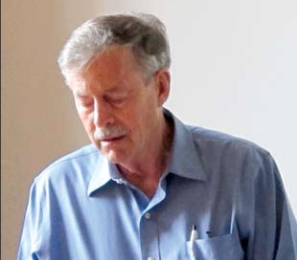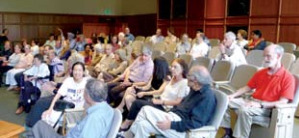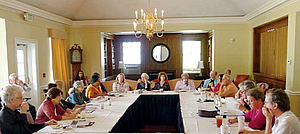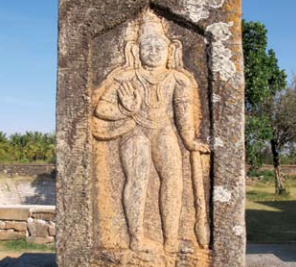
Centre of Jaina Studies Newsletter: SOAS - University of London
This symposium brought scholars to Amherst College to honour retiring Lawrence Alan Babb, the Willem Schupt Professor of Asian Languages and Civilizations at Amherst College. A distinguished anthropologist, Babb has published widely, his most recent works being two ethnographic monographs on merchant communities in Rajasthan. The symposium held in his honor took place 13-15 July 2012, which felicitously coincided with Babb's receipt of the first copy his latest monograph, Emerald City: The Birth and Evolution of an Indian Gemstone Industry, which is forthcoming from the State University of New York Press.
Because of Babb's abiding interest in Jainism, the conference, which was organized by Professors John Cort (Denison University) and Maria Heim (Amherst College), drew together scholars who have written extensively on Jainism and/or Rajasthan. All the participants had been colleagues and associates who benefitted from Babb's scholarship, including those who had engaged with him in scholarly conversations, some over the course of many years.
On the first night of this three-day celebration, Babb delivered the keynote address entitled, 'Emerald City', which was based on his ethnography on the gemstone industry in Jaipur. His talk explored the businesses of cutting and trading precious gems in the city. Babb analyzed participation by Jains and artisans from a variety of communities. Having commented on historical trading connections between India and Europe, he noted similarities between Jaipur's gem business and the diamond trade in New York City.
The following two days were devoted to presentations by panels of scholars, who briefly recapped major points in their previously circulated papers, many of which were about Jainism or provided rich context for the study of Jainismespecially, though not exclusivelyin Rajasthan, the site of so much of Babb's fieldwork. Two panels were exclusively devoted to Jain topics: 'Jains in Western India' and 'Jains in Jaipur'. The symposium format provided time for rich and interdisciplinary conversations.
Phyllis Granoff (Yale University), whose paper treated shared Jain culture in western India, argued that after Rajasthani and Gujarati became distinctive languages, Jain authors in Rajasthan and Gujarat continued to compose texts in Maru-Gujara and so maintained a shared textual culture. Peter Flügel (SOAS) delivered a paper on Sthānakavāsī mendicant orders in Rajasthan and nearby areas. Flügel presented his translation of the Sohanlāl Paṭṭaka, an 1895 text on vernacular monastic organizational rules (maryādā) thought to be lost by the tradition itself, and offered a brief analysis of its structure and historical significance for the modern Sthānakavāsī monastic reform movement and the constitution of the Śramaṇa Saṅgha. Whitney Kelting (Northeastern University Boston) reflected on constructions of gender in Gujarati and Rajasthani Jains living in Maharashtra. John Cort explored allegorical treatments of bhakti themes in North Indian Digambar songs in Hindi about Holī during the seventeenth and nineteenth centuries. He stressed that these Digambar songs employ allegory transforming the transgressive and potentially violent aspects of Holi as a social festival into a metaphor for the interior spiritual quest. The songs tend to emphasize meditation and focus on the union of consciousness and right belief.

Monika Horstmann (University of Heidelberg) discussed Vaiṣṇava elites at the Jaipur court in the late eighteenth century and analyzed the impact of their ascendance to power on merchants, especially Jains, who were persecuted during a period of rivalry between Puṣṭimārgiya and Jain merchant communities when the Audumbara brahmins, who were also Vaiṣṇavas, swelled the ranks of elites with a penchant for the Puṣṭimārg. Elena Karatchkova (Institute of Oriental Studies, Russian Academy of Sciences, Moscow) contributed a paper exploring various sources shedding light on the history of Amber's Saṅghī Jhūṅthārāmjī Temple, which was converted from a Jaina to a Shaiva temple after its initial construction by Mohan Das, a Jain prime minister in the seventeenth century. Lindsey Harlan (Connecticut College) analyzed narratives about two Jain figuresa devoted wife (satī) and a tantric mendicant (jati)who are credited by devotees of the popular Mewar hero (sagasjī) Sultan Singh with having healed a tragic rift in the Mewar royal family during the seventeenth century. Surendra Bothra (Prakrit Bharati, Jaipur) contemplated modes of absorption and application of knowledge. He reflected on his own experiences of interacting with and learning from key learned people he has known, including his father, Shri Shubh Karan Singh Bothra, who engaged in revolutionary activities during the nationalist period while remaining a devout Jain keenly interested in religion.
Among those papers that did not directly deal with Jain topics was Varsha Joshi's (Institute of Rajasthan Studies, Jaipur) contribution, which served as an instructive complement to Babb's keynote address. Focusing on Jaipur's jewelry artisans, who belong to various communities, she explored various factors affecting Jaipur's handicraft market, among them the expanding international market and migration by villagers into the city, especially Jaipur. Dominique-Sila Khan (Institute of Ismailis Studies) traced the diverse sacred geography of Jaipur, including shrines for folk deities and dargas to the north, south, east, and west of Jaipur. Khan analyzed innovations in narrative traditions and their correlation with changing representations of communities in the city.
Ann Gold's (Syracuse University) paper on the Rajasthani town of Jahazpur addressed origin myths about this qasba, a walled and gated market town that was dominated for centuries by Vaiṣṇava and Jain merchants. She examined constructions of the morality of exchange among merchants and entrepreneurs in this town whose narratives often characterize it as ruthless. Daniel Gold's (Cornell University) paper treated Jahazpur's followers of Baba Jaigurudev, who traced his descent from Radhaoswami Maharaj. He characterized various local practices, including energetic proselytization and avid social criticism by core Gurudev devotees in the qasba. Gold contextualized these through comparison with practices other contexts, including Gwalior and Mathura.
Like Phyllis Granoff's paper on texts, Michael Meister's (University of Pennsylvania) presentation on architecture challenged the definition of presentday Rajasthan as a unique region. He traced cultural continuities among various communities across the 'sandy place' (registan) extending from Rajasthan into Pakistan and Afghanistan, and belying the political partition effected in 1947.
Catherine Clémentin-Ojha (EHESS, Paris) considered Rajasthan in the context of empire; her topic was Jaipur's Maharaja Madho Singh II's voyage to England for the coronation of King Edward VII. She detailed the elaborate preparations undertaken to assure that the ruler did lose caste purity when he crossed the 'black waters'. Her paper galvanized extensive discussion of the precautions undertaken on the brand new ship in which the king traveled and also his time in England in the context of more routine travel by migrant and trading groups, including Jains.

John Stratton Hawley (Barnard College) examined relations and tensions between Vaiṣṇava orders in eighteenth-century Jaipur under the rule of Jaisingh II. Hawley explored the politically useful construct of the 'four orders' (sampradāya) that traced their heritage to South Indian Vaiṣṇavism. He suggested that this legitimation schema, which leaves the Rāmānandīs out, may have been invented by the Gauḍīyas. Hawley also analyzed sixteenth-century textual evidence for the Gaudīyas' association with the Madhva Sampradāy and questioned whether the concept of the four orders was Rajasthani 'root and branch' or resulting from a 'wider, deeper, and more tangled' cultural history.
Other stimulating contributions to the scholarship on regional society, history and polity included a paper by Frances Taft (Washington DC), who assessed several factors contributing to Akbar's expanding influence in Rajasthan: marriages with Rajputs, use of Rajput soldiers, and employment of Rajput courtiers. Carol Henderson's (Rutgers College) contribution focused on memories of 1857's war/ 'mutiny' in the context of Marwari folk performances (khyāl). Susanne and Lloyd Rudolph (University of Chicago) gave a joint paper that treated James Tod's scholarship as vernacular history and, more generally, assessed the impact of bardic accounts on the history of Rajasthan. They also spoke of the impact of Tod's writings on colonial and nationalist politics.

Shail Mayaram (Centre for the Study of Developing Societies, Delhi) looked at shifting notions of secularism in Rajasthan, examined tensions and modes of cooperation among communities in the colonial and post-colonials periods, and contrasted the complex dynamics of nationalism in Rajasthan with that of Gujarat. Surjit Singh (Institute of Development Studies, Jaipur) delivered a paper on the Jats in light of their classification as 'Other Backward Classes' in Rajasthan. Singh provided a brief history and analysis of their distribution in Rajasthan and elsewhere. Like many of the other papers, Singh's located the community in a context not circumscribed by state boundaries and considered the fluidity of these boundaries as well as the significance of this group in terms of pressing national questions of communal identity.
The concluding paper was given by T. N. Madan (Delhi University), who related many personal experiences of growing up in and writing on India in order to analyze the personal experiences he shared with the group in light of developments in anthropological and interdisciplinary theories over the decades of his career. These reflections served as the implicit culmination of the symposium, which had begun with Babb's talk and now ended with the remarks of Madan, one of Babb's long-time colleagues, also retired after a distinguished career as an anthropologist. Both scholars had made a lasting impact on the research of many those attending the symposium, and also so many other students of anthropology, religion, history, and politics.
With these papers and the rich discussion they sparked, the symposium proved a marvelous opportunity for scholars to reflect on Babb's career and to consider with zeal his work on merchant communities. The result was a weekend in which Jainism was front and center in this meeting on Rajasthan.
Lindsey Harlan is Chair of Religious Studies at Connecticut College. She is the author of Religion and Rajput Women (California), and The Goddesses' Henchmen (Oxford) She is currently is working on a book on urban hero worship in Udaipur.

 Lindsey Harlan
Lindsey Harlan